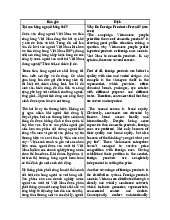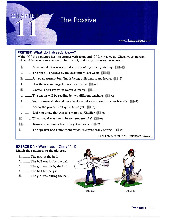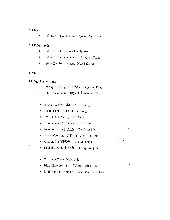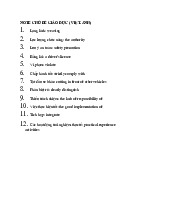



Preview text:
Translation of literary works What makes a text literary?
● created for aesthetic purposes
● beyond real or objective content: ý là k phải unreal mà nó realistic (happen in real life) ● varied uses of language
● open to multiple interpretations Should be aware and beware:
Novel: setting, plot, character, pov, theme
Poetry: term, verse, stanza (khổ thơ), rhythm (nhịp điệu), meter, rhyme 1. Concepts Interpretation Recreation - Fidelity:
Fidelity: to the source material, definitely yes. But to what aspects of the original? ● To form or content? ● Or to both? ● To what extent?
➔ Generally speaking, the translator is expected not to be a he (giống đực) at all but a traditional she (giống cái) he = authority (author) she = fidelity (translator)
➔ The word “traduction” is feminine in French, lending itself to be used in the metaphor “les belles infidèles”. Adaptability
Literary translation: an intricate process:
➔ Literary translation requires a balance of fidelity to the source material and the necessary
freedoms to adapt to the peculiarities of the target language. Idiomatic expressions: Are you pulling my leg?
➔ Anh đang kéo chân tôi hả? (literal translation, infidelity)
➔ Anh định gạt tôi hả? (fidelity to content, not form)
➔ Anh định xỏ mũi tôi hả? (fidelity to both form and content) Cliches (sáo ngữ):
vd: cold as ice, going bananas, driving me crazy, take a chill pill… - Modified cliches:
“chảnh như Khá bảnh”
as vain as a peacock (excessively proud of one’s appearance, possessions, or accomplishments, to
the point of arrogance or boastfulness) as vain as donald trump WHICH IS BETTER? WHY?
Ta chớ quên một sự thật là người Việt, tuy bị một ngàn năm đô hộ của giặc Tàu, vẫn luôn giữ được
bản sắc của dân tộc mình.
a) The fact remains that the Vietnamese, despite being under a thousand years of Chinese rule, have
always preserved their national identity.
b) Let us not forget the truth that the Vietnamese, despite being under a thousand years of Chinese
rule, have always preserved their national identity.
➔ Dùng forget the fact chứ không dùng forget the truth Collocation:
Collocation is a predictable combination of words”, for example we can say:
- heavy rain but not strong rain
- seriously damaged but not seriously destroyed
- mỡ lợn or mỡ heo, but bánh da lợn not bánh da heo, vợ chồng tôi but not chồng vợ tôi… Fidelity vs adaptability:
Culture and levels of formality:
Source-oriented or target oriented? (hướng nguồn hay hướng đích?)
This brings us back to les belles infideles. Would you prefer?
a) Fidelity to the source text (retention of meaning as it is originally expressed) or
b) Fluency in the target language (adaptability of meaning to make the translation sound natural)? Translation challenge 1:
Khôn từng xu ngu bạc vạn
➔ Careful about small amounts of money but wasteful of large sums (fidelity to content but not form)
➔ PENNY-WISE POUND-FOOLISH (fidelity to both form and content)
Localization (bản địa hóa): Further practice:
In day-to-day life, beauty may influence a person at the first impression stage, compared to when
meeting the more average-looking person. This will therefore influence the person’s judgements during an interaction.
But in the medium to long term, people generally base their liking of a person on their other traits and
will discount their physical ‘ideal’ if the personality appeals. As we are always hearing: ‘Beauty is
only skin deep’ and ‘Beauty is in the eye of the beholder’.
You might like to know American playwright Jean Kerr’s ‘take’ on this:
‘“I’m tired of all this nonsense about beauty being only skin-deep. That’s deep enough. What do you
want - an adorable pancreas?” Translation challenge 2:
A husband and a wife should be incompatible: he should have the income, she should be patentable. 2. Strategies 3. Imbalance Case 1:
Bùi Giáng’s translation of Emily Dickinson’s poem “My life closed twice before its close”
Trong khi dịch, nên giữ cho được phong cách tác giả. Nhưng với một số nhà thơ có bản lĩnh, cá tính
quá lớn như Bùi Giáng hay Xuân Diệu thì họ dịch thơ ai cũng ra thơ họ” (Dương Tường)



